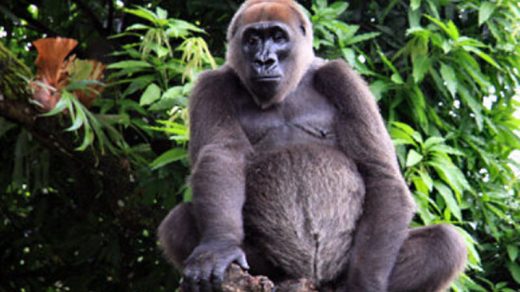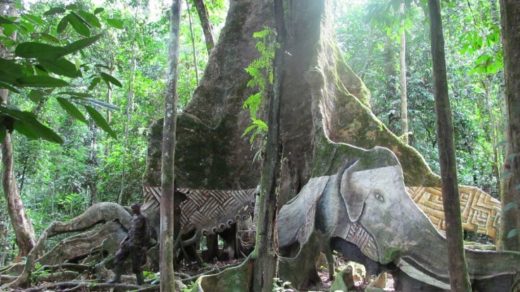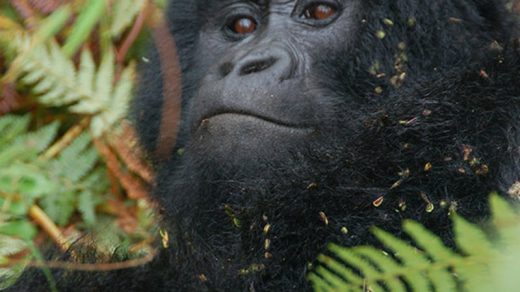Virunga National Park (Parc National des Virunga) in the eastern part of the Democratic Republic of the Congo has been listed as a UNESCO World Heritage Site since 1979, and was declared a Ramsar Wetland in 1996. It is known for its rich diversity of habitats and for the many endemic species that exist here.
Primates present in the park:
- Mountain gorilla
- Common chimpanzee
- Golden monkey
- Red-tailed monkey
- Dent’s mona monkey
- Blue monkey
- Hamlyn’s monkey
- De Brazza’s monkey
- Central African red colobus
- Mantled guereza
- Olive baboon
- Grey-cheeked mangabey
The northern part of the park connects to the Semuliki park and the Rwenzori Mountains National Park in Uganda, the central part of the park connects to Queen Elizabeth National Park in Uganda, and the southern part of the park connects to the Volcanoes National Park in Uganda.
Both gorillas (Gorilla beringei) and golden monkey (Cercopithecus kandti) live in Virunga National Park, but are under threat due to habitat destruction, illegal hunting for bushmeat, and the general violence and civil unrest plaguing the region. Since 1994, the whole park has been listed as a UNESCO World Heritage in Danger. There has been many deadly attacks on park staff, including anti-poaching rangers.
The park is governed by Institut Congolais pour la Conservation de la Nature. In 2005, the European Commission recommended a public-private partnership between the country´s government and the British NGO African Conservation Fund, in order to better protect the park. Since 2010, the African Conservation Fund has been responsible for park management, and roughly 80% of the management costs are subsidies by the European Commission. This has resulted in a militarization of the park, to deter armed rebel groups and poachers. Park staff now receive military training and high-quality weapons, and operate in conjunction with state security services and the army.
How large is Virunga National Park?
The park is 8,090 square kilometres.
From north to south, the park extends approximately 300 km.
Where is Virunga National Park?
Coordinates: 0°55′S 29°10′E
Virunga National Park is found in the eastern par of the Democratic Republic of the Congo.
The closest city is Goma.
From north to south, the park largely follows the international borders to Uganda and Rwanda.
The park is a part of the African Great Lakes region.
Geography and nature
- Lowest point: 680 metres above sea level, in the Semliki River valley
- Highest point: 5,109 metres above sea level at the peak of Mount Stanley in the Rwenzori Mountains
- There are two active volcanoes in the park: Mount Nyiragongo and Mount Nyamuragira
- The Virunga National Park is part of the Congo-Nile watershed area.
- Roughly two-thirds of Lake Edward is located within the park (up to the border to Uganda).
- The southern part of the park reaches the shores of Lake Kivu.
- The driest part of the park is the savannah around Lake Edward, which receives a mean monthly rainfall of 30-40 mm. The northern part of the park is much wetter, and gets a mean monthly rainfall of up to 220 mm. Precipitation is not evenly distributed around the year, as there are two distinct rainy seasons in the park: March to mid-May and September to November.
- Temperatures drop with altitude, from an average of 23–28 °C (73–82 °F) at lower altitudes to an average of 16–24 °C (61–75 °F) higher up.
- Over 2,000 plant species have been identified within the park, including many that are endemic to the Albertine Rift.
- The plains of the park are chiefly wetlands and grasslands. The elephants are important seed dispersers in the grassland environment.
- The montane forest grows from circa 1,800 metres to 2,800 meters above sea level, but the African alpine bamboo is typically limited to the 2,300 – 2,600 range. Above the montane forest, the subalpine forest start, characterized by a lot of African redwood trees. These redwoods grow up to an altitude of circa 3,000 metres. Heather, tree heath and mosses take over the landscape from circa 3,700 metres.
- 196 mammals have been identifed in the park, and the park is also home to over 700 bird species, 100+ reptile species, and 65 amphibian species.
Fauna
Examples of animal species living in the park:
- Mountain gorilla
- Common chimpanzee
- Golden monkey
- Red-tailed monkey
- Dent’s mona monkey
- Blue monkey
- Hamlyn’s monkey
- De Brazza’s monkey
- Central African red colobus
- Mantled guereza
- Olive baboon
- Grey-cheeked mangabey
- Lion
- African leopard
- Nile crocodile
- Marsh mongoose
- African bush elephant
- Hippopotamus amphibius
- African buffalo
- Okapi
- Aardvark
- Bongo
- Giant forest hog
- Ugandan kob
- Waterbuck
- Common warthog
- Giant pangolin
- Tree pangolin
- Crested porcupine
- Western tree hyrax
- Rwenzori batis
- Kivu ground thrush
- Stripe-breasted tit
- Handsome spurfowl
- Strange weaver
- African goshawk
- Wahlberg´s eagle
- Hadeda ibis
- Brown-necked parrot
History
The the early 1920s, several conservationists championed the idea of creating a protected wilderness area in the north-eastern part of Belgian Congo. In 1925, Albert National Park was established –
Congo´s very first national park. It was not only a preserve for wildlife; it was also considered a protected area for hunter-gatherer African Pygmy populations.
In 1926, the park covered 500 square kilometres around Mount Kirisimbi and Mount Mikeno. In 1929, the protected area in Congo was increased by the establishment of Virunga National Park, which then encompassed the Virunga Mountains, parts of the Rutshuru Territory, and the plains located south of Lake Edward. In the following decades, the protected area became even greater, as it was extended step-by-step.
From the late 1930s to 1955, an estimated 85,000 local people were forcibly moved from their land to nearby Masisi in North Kivu, losing their traditional land rights. In the late 1950s, Tutsi herders entered into the protected land with their cattle, which caused habitat destruction up to an altitude of roughly 3,000 metres.
After Belgian Congo became the independent Republic of the Congo, land laws were reformed in the 1960s. Illegal hunting within the protected area increased.
Merging of the two parks
In 1969, Albert National Park and Virunga National Park were merged into one park, and Albert was dropped form the name.
Crude oil extraction
In 2011, the British company Soco International received a concession from the Congo government to extract crude oil in large parts of Virunga National Park and in surrounding areas. The park management opposed this, and in April 2014 an attack on park chief Emmanuel de Mérode brought increased international attention to the situation. Following an international outcry against Soco, the company seized their exploration activities in and near the park, and agreed to refrain from starting similar operations in and near World Heritage Sites in the future.
Hydropower
By 2016, four hydropower dams had been constructed to provide electricity locally.
Armed conflict
Since the 1990s, Virunga National Park has been impacted by the armed conflict and instability plaguing the African Great Lakes region.
One aspect of this is the Rwandan genocide, which prompted thousands of refugees to seek shelter in the Kivu region. Also, the First and Second Congo Wars brought increased violence and military presence to the protected area, the work of the anti-poaching staff was obstructed, and some park staff were killed, alongside a lot of wildlife.
By 1994, approximately 850,000 refugees lived around the national park, and up to 40,000 people entered the park each day in search of food and firewood. Huge tracts of land were deforested. Between 1996 and 2003, 80 members of the park staff were killed in confrontations with rebel groups.
Examples of ethnic groups currently living in and near Virunga National Park are Mbuti, Hutu, Tutsi, and Basongora.
The violence in and near the park is not a thing of the past, and the violent conflicts that marked the late 20th century have still not been resolved. Examples of armed rebel groups currently present in the park are Democratic Forces for the Liberation of Rwanda and National Congress for the Defence of the People (FDLR).
The instability in the region contributes greatly to the destruction of the park. One example of this is the uncurbed removal of wood for charcoal. According to a 2010 report by the United Nations Security Council, 80% of the charcoal used in Goma, the nearest city, is sourced from within the park. This business represents a value of roughly 28-30 million USD per year.
Examples of recent killings in the park:
- Five park rangers were killed by milita in August 2017.
- Five park rangers and a driver were killed in April 2018.
- In May 2018, a park ranger was killed while defending two kidnapped tourists. The tourists were subseqently released, and the park remained closed to visitors from June 2018 to February 2019.
- In April 2020, a dozen park rangers were killed when milita attacked a civilian convoy.
- In January 2021, armed men killed six park ranger and wounded several others in an ambush.
- On 22 February 2021, Italy´s ambassador to the DRC, the Italian military police officer Vittoria Iacovacci, and the Congolese driver Moustapha Milambo were killed by gunfire after their convoy had been hijacked by militia and forced to enter the park. (The ambassador had been in the region to visit representatives of the World Food Programme roughly 15 km north of Goma.) Four of the kidnapped persons in the convoy were freed by park rangers who attacked the militia.


